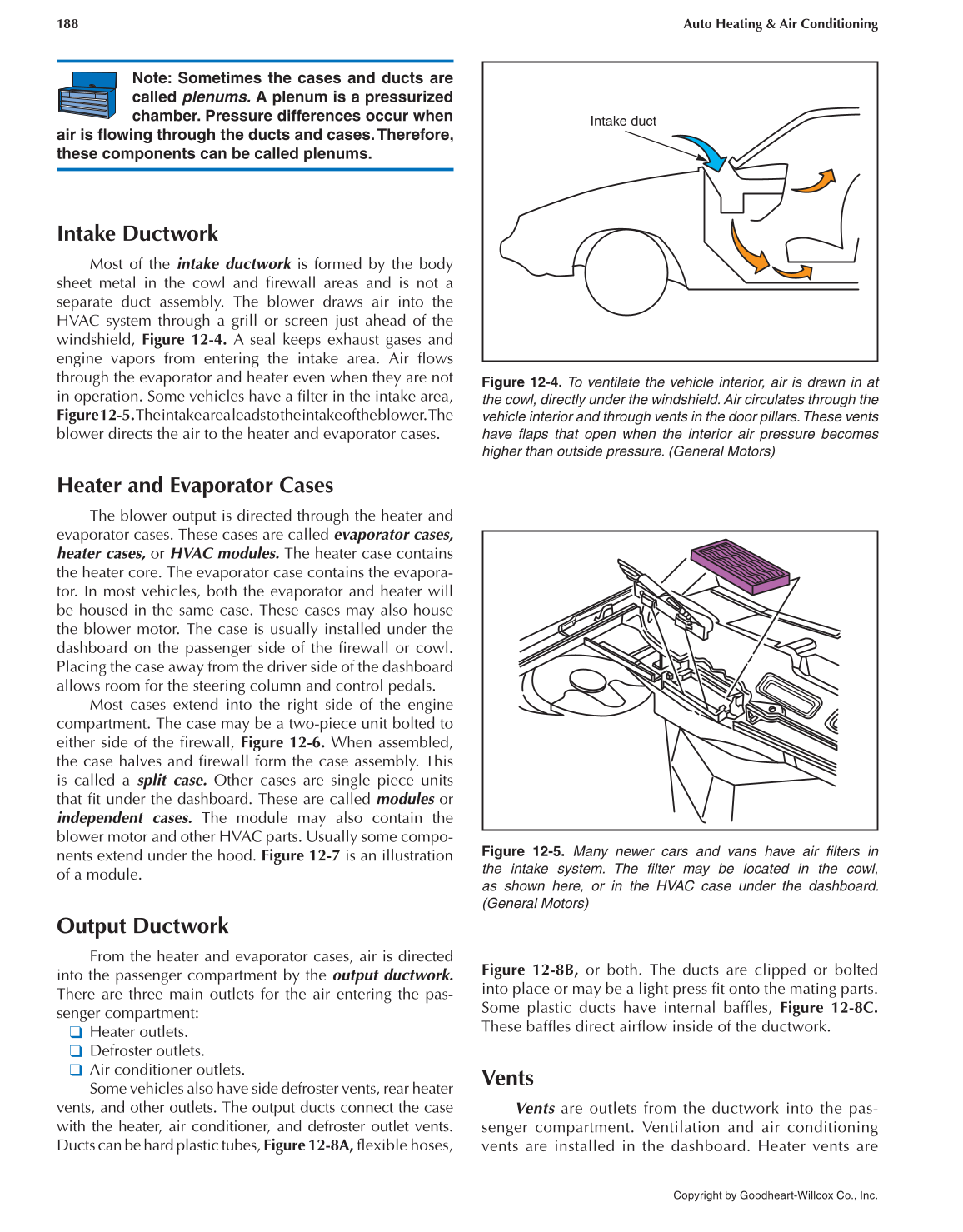188 Auto Heating & Air Conditioning
Copyright by Goodheart-Willcox Co., Inc.
Note: Sometimes the cases and ducts are
called plenums. A plenum is a pressurized
chamber. Pressure differences occur when
air is fl owing through the ducts and cases. Therefore,
these components can be called plenums.
Intake Ductwork
Most of the intake ductwork is formed by the body
sheet metal in the cowl and fi rewall areas and is not a
separate duct assembly. The blower draws air into the
HVAC system through a grill or screen just ahead of the
windshield, Figure 12-4. A seal keeps exhaust gases and
engine vapors from entering the intake area. Air fl ows
through the evaporator and heater even when they are not
in operation. Some vehicles have a fi lter in the intake area,
Figure 12-5. The intake area leads to the intake of the blower. The
blower directs the air to the heater and evaporator cases.
Heater and Evaporator Cases
The blower output is directed through the heater and
evaporator cases. These cases are called evaporator cases,
heater cases, or HVAC modules. The heater case contains
the heater core. The evaporator case contains the evapora-
tor. In most vehicles, both the evaporator and heater will
be housed in the same case. These cases may also house
the blower motor. The case is usually installed under the
dashboard on the passenger side of the fi rewall or cowl.
Placing the case away from the driver side of the dashboard
allows room for the steering column and control pedals.
Most cases extend into the right side of the engine
compartment. The case may be a two-piece unit bolted to
either side of the fi rewall, Figure 12-6. When assembled,
the case halves and fi rewall form the case assembly. This
is called a split case. Other cases are single piece units
that fi t under the dashboard. These are called modules or
independent cases. The module may also contain the
blower motor and other HVAC parts. Usually some compo-
nents extend under the hood. Figure 12-7 is an illustration
of a module.
Output Ductwork
From the heater and evaporator cases, air is directed
into the passenger compartment by the output ductwork.
There are three main outlets for the air entering the pas-
senger compartment:
Heater outlets.
Defroster outlets.
Air conditioner outlets.
Some vehicles also have side defroster vents, rear heater
vents, and other outlets. The output ducts connect the case
with the heater, air conditioner, and defroster outlet vents.
Ducts can be hard plastic tubes, Figure 12-8A, fl exible hoses,
Figure 12-8B, or both. The ducts are clipped or bolted
into place or may be a light press fi t onto the mating parts.
Some plastic ducts have internal baffl es, Figure 12-8C.
These baffl es direct airfl ow inside of the ductwork.
Vents
Vents are outlets from the ductwork into the pas-
senger compartment. Ventilation and air conditioning
vents are installed in the dashboard. Heater vents are
Figure 12-4. To ventilate the vehicle interior, air is drawn in at
the cowl, directly under the windshield. Air circulates through the
vehicle interior and through vents in the door pillars. These vents
have fl aps that open when the interior air pressure becomes
higher than outside pressure. (General Motors)
Intake duct
Figure 12-5. Many newer cars and vans have air fi lters in
the intake system. The fi lter may be located in the cowl,
as shown here, or in the HVAC case under the dashboard.
(General Motors)
